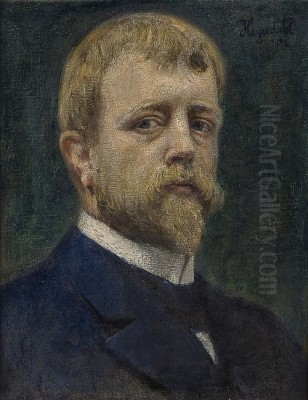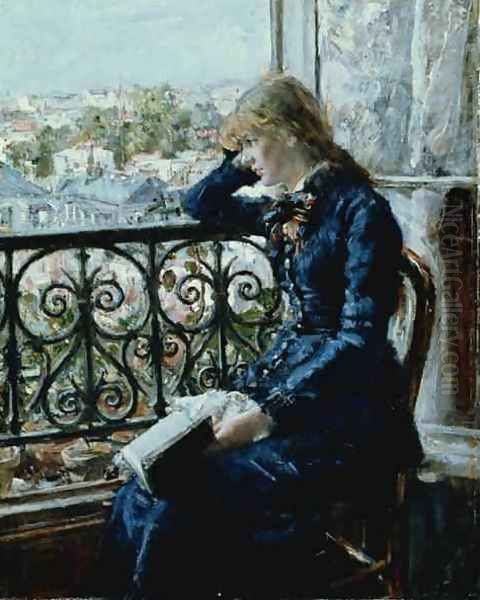
Hans Olaf Heyerdahl stands as a significant figure in Norwegian art history, a painter whose career bridged the academic traditions of the 19th century with the burgeoning movements of Realism and Naturalism. Active during a transformative period for Scandinavian art, Heyerdahl developed a distinctive style characterized by technical proficiency, a sensitive handling of light and color, and a deep engagement with both the human figure and the natural landscape of his homeland. His journey took him from Norway to the major art centers of Munich and Paris, experiences that profoundly shaped his artistic vision while allowing him to retain a uniquely Nordic sensibility.
Early Life and Artistic Awakening
Hans Olaf Heyerdahl was born in Smedjebacken, Sweden, in 1857, to Norwegian parents. His family background was one of intellectual engagement; his father was an accomplished engineer, occasionally practicing architecture, and also possessed a literary inclination, writing Nordic epic poetry. Described as enlightened yet conservative, the family environment likely fostered a respect for both tradition and inquiry. Heyerdahl spent his formative years in Drammen, a town near Kristiania (now Oslo), where he received his early education. It was here that his artistic talents began to emerge, leading him toward a formal path in the arts.
Recognizing his potential, Heyerdahl enrolled at the National College of Art and Design (then known as the Royal School of Drawing) in Kristiania in 1873. This institution was a cornerstone of art education in Norway at the time. During his studies there, he came under the tutelage of Peder Severin Krøyer, a painter who would himself become one of the most celebrated figures of the Skagen Painters group, known for his luminous depictions of Danish coastal life. This early training provided Heyerdahl with a solid foundation in drawing and painting fundamentals, preparing him for further studies abroad.
Formation in Munich

Seeking advanced training, Heyerdahl made the pivotal decision to move to Germany in 1874. He enrolled at the prestigious Academy of Fine Arts in Munich (Akademie der Bildenden Künste München). Munich was then a major European art center, rivaling Paris, particularly known for its strong tradition in history painting and a developing school of Realism characterized by dark palettes and dramatic lighting, often referred to as the "Munich School."
At the Munich Academy, Heyerdahl studied under influential professors, including Ludwig von Löfftz and Wilhelm von Lindenschmit the Younger. These instructors were proponents of the meticulous technique and historical subject matter favored by the Academy. Under their guidance, Heyerdahl honed his technical skills, mastering anatomy, composition, and the handling of oil paint according to academic standards. His early works from this period often reflected the prevailing Munich style, focusing on historical and genre scenes executed with considerable detail and tonal sophistication. The Munich experience was crucial in developing his technical mastery.
Emergence of a Realist Painter
While the Munich training was rigorous, Heyerdahl, like many artists of his generation, began to gravitate away from purely historical subjects towards a more direct engagement with contemporary life and the observable world. This shift aligned with the broader European movement towards Realism and Naturalism, which emphasized truthfulness to nature and the depiction of ordinary subjects without idealization. His time in Munich exposed him to artists exploring these new directions, such as Wilhelm Leibl and Fritz von Uhde, who were challenging academic conventions.
Heyerdahl's artistic inclinations increasingly led him towards portraiture and genre scenes drawn from everyday life. He developed a keen eye for capturing the individuality of his sitters and the nuances of human interaction. His palette began to lighten somewhat, and his interest in the effects of light became more pronounced, although still often within the tonal framework learned in Munich. This period marked the beginning of his synthesis of academic technique with a more modern, observational approach.
Parisian Influence and International Recognition
Seeking new artistic stimuli and exposure to the latest trends, Heyerdahl spent significant time in Paris between 1878 and 1882. Paris was the undisputed center of the avant-garde, home to Impressionism and a vibrant strain of Naturalism championed by artists like Jules Bastien-Lepage. The annual Paris Salon was the premier venue for artists seeking international recognition, and Heyerdahl successfully exhibited his work there.
His time in Paris proved transformative. He absorbed the lessons of French Realism and Naturalism, admiring the objective yet sensitive portrayal of rural life and contemporary society found in the works of Bastien-Lepage and others. While not fully embracing the broken brushwork and high-keyed palette of the Impressionists like Claude Monet or Camille Pissarro, he was undoubtedly influenced by their attention to light and atmosphere, particularly the way light could define form and create mood. This is evident in works like At the Window (1881), which showcases his skill in rendering subtle indoor light and a pensive human presence, earning him the prestigious Grand Prix du Florence at the Paris Salon in 1882.
Another significant work from this period, The Dying Child (Døende barn), painted in 1882, garnered considerable attention. This poignant depiction of grief and childhood mortality reflected the social concerns often addressed by Realist painters and demonstrated Heyerdahl's ability to convey deep emotion with sensitivity and technical skill. His success in Paris established his reputation on an international stage and marked him as a leading figure among the younger generation of Norwegian painters.
Return to Norway and Mature Style
After his formative years abroad, Heyerdahl returned to Norway, eventually settling primarily in Kristiania but also spending time in the coastal town of Asgårdstrand, a location later famously associated with Edvard Munch. Back in his homeland, Heyerdahl continued to develop his personal style, increasingly focusing on Norwegian subjects and landscapes while integrating the techniques and sensibilities acquired in Munich and Paris.
His work from this period often features portraits, intimate genre scenes, and evocative landscapes. He became particularly known for his sensitive depictions of women and children. Strawberry Girl (Jordbærpike), painted in 1887, is a prime example of his mature style. The painting captures a young girl in a moment of quiet contemplation, rendered with delicate brushwork, a warm palette, and a gentle naturalism that avoids sentimentality. It highlights his skill in portraying youthful innocence and his mastery of light filtering through foliage.
Another celebrated work is Young Lady, Moonlight Night, Asgårdstrand. This painting, sometimes earning him the moniker "Nordic Renoir" for its charm and atmospheric quality, depicts a woman bathed in the soft glow of moonlight by the shore. It exemplifies his ability to capture the specific mood and light of the Nordic summer night, blending realistic observation with a subtle romanticism. His landscapes often depicted the fjords and coastal areas of Norway, showcasing his love for his native scenery and his ability to render its unique atmospheric conditions.
Technical Experimentation and Mastery
Throughout his career, Heyerdahl demonstrated a profound interest in the technical aspects of painting, experimenting with materials and methods to achieve specific visual effects. His time in Munich likely sparked this interest, as the academy there encouraged research into historical painting techniques. He was particularly noted for his sophisticated use of oil paints and mediums.
Sources indicate he studied and adapted techniques associated with the Swiss Symbolist painter Arnold Böcklin, known for his own technical innovations. Heyerdahl experimented with mixed techniques, sometimes referred to as a form of "tempera," though distinct from traditional egg tempera. This likely involved combining oil paints with resins or other binding agents to achieve particular effects of luminosity, transparency, and surface texture. He employed transparent glazes skillfully, building up layers of color to create depth and richness. This technical curiosity contributed to the unique visual qualities of his paintings and sometimes resulted in complex aging patterns, making the conservation of his work a specialized field.
Themes and Subjects: Nature, Humanity, and Light
Heyerdahl's oeuvre revolves around several key themes. Portraiture remained central, showcasing his ability to capture not just likeness but also the psychological presence of his subjects. His portraits range from formal commissions to more intimate studies of friends and family. He had a particular affinity for depicting women and children, often capturing moments of quiet introspection or everyday activity with empathy and grace.
Landscape painting was another vital aspect of his work. He painted the Norwegian coast, the fjords, and the countryside, demonstrating a deep connection to the natural environment. His landscapes are characterized by their atmospheric depth, careful observation of light conditions – whether the bright sun of midday, the soft glow of twilight, or the ethereal light of a moonlit night – and a realistic rendering of topography and vegetation. Works painted in Asgårdstrand are particularly noted for their lyrical quality.
Genre scenes, depicting moments from daily life, allowed Heyerdahl to combine his skills in figure painting and environmental rendering. These scenes often possess a narrative quality, hinting at stories or relationships without being overly anecdotal. Across all his subjects, a fascination with light is a unifying element. He masterfully manipulated light and shadow to model form, create mood, and unify his compositions, whether depicting figures indoors, figures in a landscape, or pure landscape itself.
Place in Norwegian and European Art
Hans Olaf Heyerdahl occupies an important position within the context of late 19th and early 20th-century Norwegian art. He belonged to a generation of artists, including Christian Krohg, Erik Werenskiold, Frits Thaulow, Gustav Wentzel, and Harriet Backer, who broke away from the dominant Düsseldorf School influence of earlier Norwegian painting and embraced the more contemporary currents of Realism and Naturalism emanating from Munich and Paris.
He maintained connections with fellow artists. His style shares affinities with Werenskiold's robust realism and Thaulow's atmospheric landscapes. He is known to have spent time with the Swedish painter Richard Bergh in Visby, on the island of Gotland, during the 1890s, indicating his participation in the broader Nordic artistic community. While distinct in style, he was also a contemporary of Edvard Munch, and although their paths diverged significantly – Munch moving towards Expressionism – they shared locations like Asgårdstrand and were part of the same Kristiania art scene. Heyerdahl's work, particularly his technical experiments and focus on light, can be seen as part of the wider European exploration of painting's possibilities during this era.
Though perhaps not as radically innovative as Munch, Heyerdahl played a crucial role in modernizing Norwegian painting. He successfully blended rigorous academic training with the observational principles of Realism and a sensitivity to light often associated with Impressionism, creating a body of work that was both technically accomplished and emotionally resonant. He exhibited widely and achieved considerable recognition during his lifetime, including awards at the Paris Salon.
Legacy
Hans Olaf Heyerdahl passed away in Kristiania (Oslo) in 1913. He left behind a significant body of work that continues to be appreciated for its technical brilliance, aesthetic appeal, and sensitive portrayal of Norwegian life and landscape. His paintings are held in major Norwegian museums, including the National Museum in Oslo, and are valued as key examples of Norwegian Realism and Naturalism.
His legacy lies in his mastery of his craft, his successful synthesis of national and international artistic trends, and his contribution to the rich tapestry of Scandinavian art at the turn of the century. He remains a testament to the enduring power of observational painting combined with personal artistic vision, capturing the nuances of light, form, and human experience with remarkable skill and sensitivity. His works like At the Window, Strawberry Girl, and Young Lady, Moonlight Night, Asgårdstrand endure as highlights of Norwegian painting from this era.